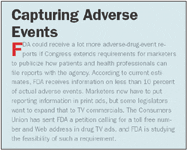FDA to Congress: "Show Us The Money"
Pharmaceutical Executive
FDA is being pressured to get its act together. The agency says it needs more money and more people to get approvals out the door
Faced with an ever-expanding portfolio of oversight and regulatory responsibilities, coupled with depleted resources and a decimated workforce, FDA is having a tough time meeting the high expectations of all its numerous constituencies.

Jill Wechsler
To make matters worse, FDA must establish a host of new rules and policies to implement the FDA Amendments Act (FDAAA), intended to boost FDA resources for drug review, at least until the agency is able to bring on board the hundreds of new staffers it needs. At the same time, the Center for Drug Evaluation and Research (CDER) is under intense pressure to beef up post-approval surveillance, which has only added to the strain on the agency.
The situation has become so serious that John Jenkins, director of CDER's Office of New Drugs (OND), is giving review division chiefs "discretion" to reduce work on some review activities, even if that means missing some user-fee deadlines.
Jenkins explained that his office cannot keep up with a growing volume of requests to meet with sponsors, provide special protocol assessments for innovative therapies, supply the reams of information demanded by Congressional committees, and still meet every goal set by the Prescription Drug User Fee program (PDUFA 4). Jenkins thus advised OND office and division directors to assess where it will be difficult to meet PDUFA review goals and to notify sponsors of anticipated delays.
Jenkins noted that there is "no specific end date" to the possibility of missing PDUFA deadlines because it may take years to hire all the necessary personnel to remedy the situation. CDER has resources to add some 400 to 500 additional staffers, but the task of hiring and training a whole new cadre of reviewers and analysts will consume considerable time and energy.
CDER is aggressively searching for qualified candidates, but must "navigate through the complex federal/HHS personnel system" before making an official job offer, Jenkins explained. The delays, plus a pay structure that often "is not competitive to what qualified candidates can make in the private sector," make it hard for FDA to attract and retain the best candidates.
While FDA has always had to play with PDUFA goal numbers, this explicit warning seems to go beyond the usual difficulties. For biopharma companies, the development raises the prospect of added costs and delays in bringing new drugs to market, a trend evident in FDA's declining drug approval rate. The agency approved only 19 innovative new drugs in 2007, 17 new molecular entities (NMEs) plus two novel biotech therapies. That's way down from the peak of 53 new drugs in 1996, but in line with a steady decline in new drug approvals since 2002. Another analysis indicates that FDA approved only 64 percent of all NDAs in 2007; instead, it issued more non-approvable and approvable letters, which usually require additional data for final approval.
Sponsors say these trends reflect a more cautious environment at the agency in approving new drugs. CDER Director Janet Woodcock maintains that FDA has not changed standards or become more risk-averse, but now has better tools for detecting and describing safety problems, especially for drugs to treat chronic conditions. FDA officials acknowledge, though, that new treatments in crowded drug classes will have to show clear advantage in efficacy or safety to gain market approval.

Capturing Adverse Events
Push for Safety
One reason drug approvals may continue to slow down is because agency staffers are devoting considerable time and resources to implementing new safety initiatives. A top priority for Woodcock is to convince critics on Capitol Hill and elsewhere that FDA can and will do more to monitor drug safety and ensure appropriate medication use. A new five-year plan spells out how FDA will spend the extra $30 million in user-fee revenues authorized by FDAAA to enhance drug safety capabilities.
To handle all these added tasks, Woodcock has expanded CDER's Office of Surveillance and Epidemiology (OSE) from three to five divisions.
One new task is to develop summaries of adverse drug events to identify new and potential risks after a product is on the market for a year or two. Another important assignment is to implement the Risk Evaluation and Mitigation Strategies (REMS) program.
In March, FDA published a list of 25 previously approved brand and generic drugs that already have some kind of restricted distribution system. These manufacturers have to file a REMS with FDA by September 21, 2008, and FDA can require a REMS for new drugs that similarly warrant special controls on drug dispensing and patient use. FDA expects to publish new guidance on key elements of a REMS to assist companies developing new drugs that raise safety issues.
CDER's "Safety First" initiative is clarifying internal processes for managing these initiatives. The aim is to better integrate pre- and post-approval safety assessment, thus avoiding future clashes between OND and OSE. Safety officials in every new drug review office will oversee and coordinate assessment of safety issues, which will involve interdisciplinary teams of experts from both offices.
Woodcock notes that OSE will have lead regulatory responsibility for observational epidemiologic studies and medication error prevention, including review of proprietary names, packaging, and container labeling. But safety officers won't get a veto over approvals, as recommended by critics both inside and outside the agency.
Safety experts also are involved in FDA's campaign to publicize information on medication safety signals as they emerge. The same week that FDA published its REMS policy, it also issued several early communications on emerging safety concerns. One involved new signals of heart attack risks involving two leading HIV/AIDS therapies, GlaxoSmithKline's Ziagen (abacavir) and Bristol-Myers Squibb's Videx (didanosine). The agency also said it would conduct a safety review of Johnson & Johnson's Regranex (becaplermin) skin gel for diabetics, in order to determine links to cancer and death. FDA also reported that it is investigating a possible connection between suicide and Merck's popular asthma treatment Singulair (montelukast).
Such announcements aim to provide information on possible medication problems so that medical professionals can alert patients appropriately. The danger is that these warnings can trigger overreactions that lead to noncompliance. Equally troubling is the prospect that a proliferation of FDA warnings may prompt patients and providers to ignore the alerts. FDA has issued more public health advisories in recent months than in most preceding years.
Show Me the Funding
By demonstrating renewed commitment to post-market surveillance, FDA officials hope to regain public trust in its operations. At the annual meeting of the Food and Drug Law Institute (FDLI) in March, former CDER director Carl Peck described FDA as operating in a "guerrilla environment" created by "ambitious politicians, media competing for headlines, and opportunistic academics." A case in point, he noted, was a widely cited study in the New England Journal of Medicine indicating that new drugs approved close to user-fee deadlines turn out to be less safe than those approved without any pressure to meet review time frames.
Not so, according to CDER deputy director Douglas Throckmorton, who pointed out that agency approval and withdrawal data is "considerably different" from what the analysts reported. FDA plans to submit its own findings to NEJM, but that's unlikely to make headlines.
The good news is that there seems to be a growing consensus that FDA needs a major boost in resources to regain its stature as an effective, science-based regulatory agency. Senator Edward Kennedy (D-MA), chairman of the Senate Health Committee, added an amendment to the Senate budget resolution for 2009 that would boost FDA's budget by a total of $375 million in the coming year, without increasing reliance on user fees.
In recent statements, FDA Commissioner Andrew von Eschenbach has become more open about FDA's funding shortfall. In a speech at the March FDLI meeting, he described FDA as a "patient in peril." Von Eschenbach noted that increased FDA reliance on user fees limits the agency's flexibility, and urged full backing for the Reagan-Udall Foundation. But at a Senate appropriations hearing last month, he said that FDA might have the trouble absorbing a $375 million boost in one year. At the same time, von Eschenbach acknowledged that the slim increase in the Administration's budget plan is too little; $200 million would be just right, he said.
Jill Wechsler is Pharmaceutical Executive's Washington correspondent. She can be reached at jwechsler@advanstar.com

Beyond the Prescription: Pharma's Role in Digital Health Conversations
April 1st 2025Join us for an insightful conversation with Jennifer Harakal, Head of Regulatory Affairs at Canopy Life Sciences, as we unpack the evolving intersection of social media and healthcare decisions. Discover how pharmaceutical companies can navigate regulatory challenges while meaningfully engaging with consumers in digital spaces. Jennifer shares expert strategies for responsible marketing, working with influencers, and creating educational content that bridges the gap between patients and healthcare providers. A must-listen for pharma marketers looking to build trust and compliance in today's social media landscape.
Talphera Cuts NEPHRO CRRT Study Size, Secures $14.8 Million Private Placement
April 1st 2025The trial size adjustment, along with protocol modifications and the addition of higher-enrollment sites, is expected to facilitate completion of the NEPHRO CRRT study of Niyad in patients undergoing renal replacement therapy by the end of 2025.